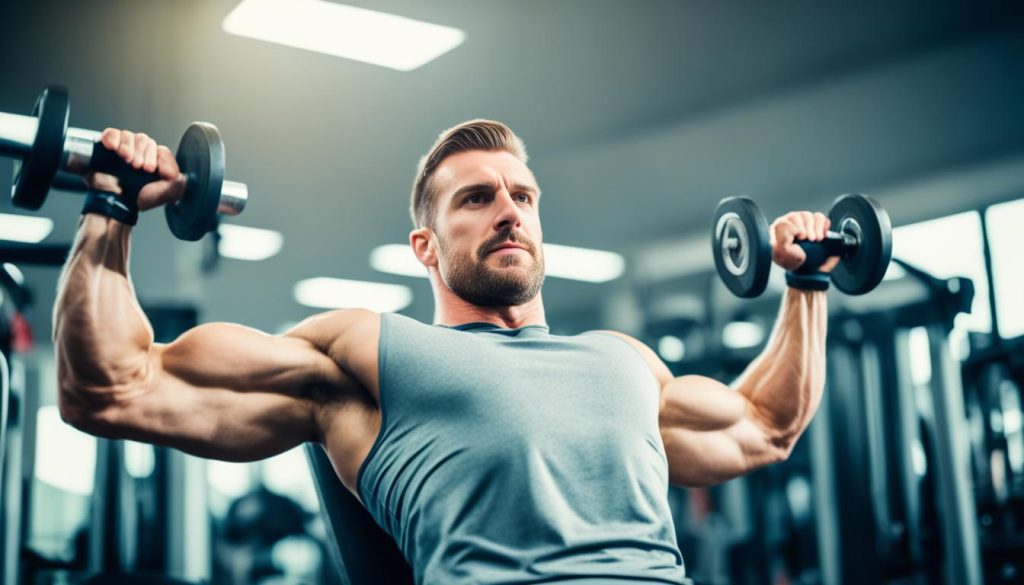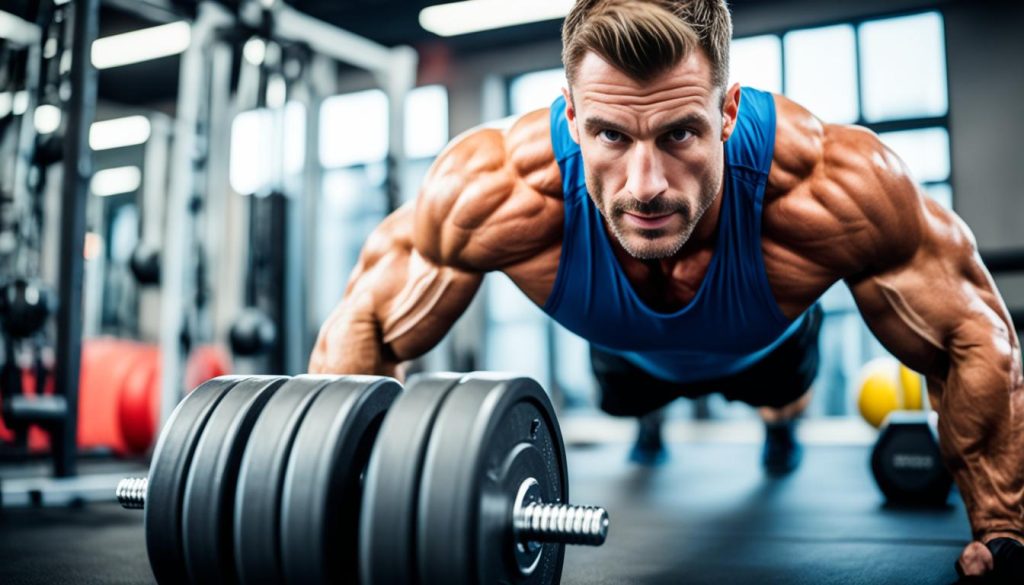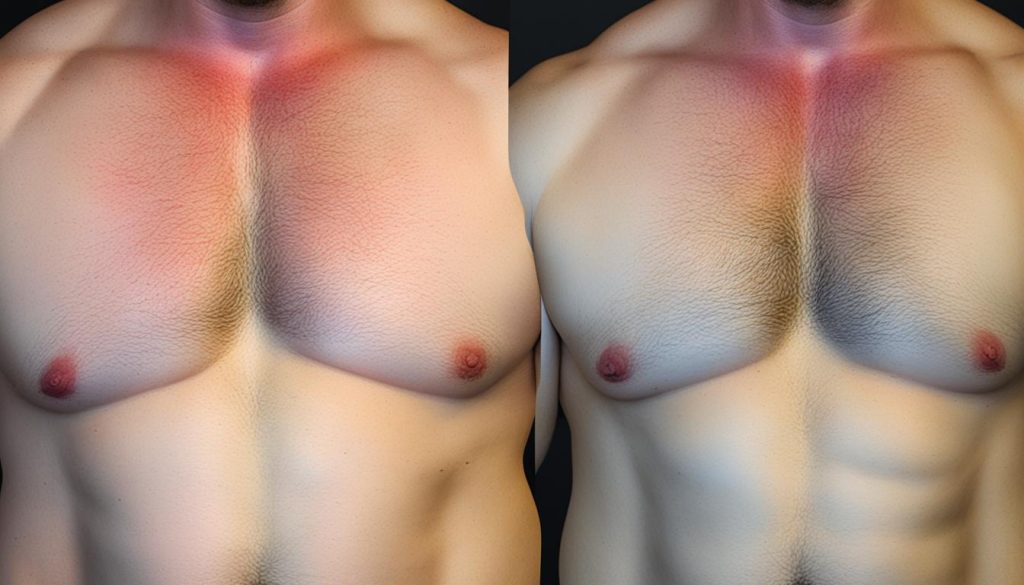If you’re looking to reduce chest fat and achieve a more sculpted chest, you’ve come to the right place. Losing chest fat involves a combination of diet, exercise, and a little bit of know-how. In this article, we’ll explore methods and tips to help you reach your goals.
Before we dive into the details, let’s first understand how fat loss works. The key principle is creating a caloric deficiency. According to the Forbes equation, burning 3,500 calories through exercise or dietary restriction can result in losing one pound of fat. By tracking your calorie intake and increasing physical activity, you can create a caloric deficiency and start shedding chest fat.
How to Lose Chest Fat?
Create a Caloric Deficiency
To create a caloric deficit and promote weight loss and chest fat reduction, it’s important to focus on healthy eating and exercise habits. By incorporating these strategies into your routine, you can achieve your goals effectively and naturally.
1. Tracking Calorie Intake
One of the first steps in creating a calorie deficit is to track your daily caloric intake. This can be done using an app or a notebook to record the foods and beverages you consume. By monitoring your calorie intake, you can determine how many calories you should be consuming to support weight loss.
2. Reducing Fat and Carbohydrate Intake
Reducing your intake of fat and carbohydrates can contribute to creating a caloric deficit. Focus on consuming lean protein, fruits, vegetables, and whole grains. These foods are nutrient-dense and can help you feel fuller for longer periods, reducing the temptation to overeat.
3. Weight Training and Cardio
Combining weight training with high-intensity cardio exercises is an effective way to burn calories and create a caloric deficit. Weight training can help build muscle, which increases metabolism and leads to more calories burned throughout the day. High-intensity cardio exercises such as running, cycling, or HIIT workouts can further contribute to calorie expenditure.
4. Restricting Caloric Intake
In addition to exercise, restricting your caloric intake can help create a deficit. Aim to consume approximately 600 calories less than your average daily caloric intake. This can be achieved by monitoring portion sizes, choosing lower-calorie options, and being mindful of snacking habits.
By combining a healthy diet with regular exercise, you can create a caloric deficiency and promote weight loss, including the reduction of chest fat. It’s important to remember that consistency and patience are key, as sustainable results take time. Consult a healthcare professional or nutritionist for personalized advice and guidance.

| Exercise | Duration | Calories Burned |
|---|---|---|
| Running | 30 minutes | 300 |
| Weightlifting | 1 hour | 400 |
| HIIT Workout | 45 minutes | 500 |
Weight-Burning Exercises for Chest
While weight-burning exercises alone won’t eliminate chest fat, they play a crucial role in toning and firming the chest area. By targeting the chest muscles, exercises such as push-ups, bench press, cable-cross, and dumbbell pullover can contribute to overall chest fat reduction. It’s essential to perform these exercises with proper form and gradually increase the intensity and weight as you progress.

Push-ups
Push-ups are a classic exercise that engage the chest muscles along with the triceps and shoulders. Start in a plank position, with hands slightly wider than shoulder-width apart and feet hip-width apart. Lower your body by bending your elbows, keeping your back straight, until your chest almost touches the ground. Push back up to the starting position. Aim for 2-3 sets of 10-15 repetitions, gradually increasing the number over time.
Bench Press
The bench press is a popular exercise that primarily targets the chest muscles. Lie flat on a bench with your feet firmly planted on the ground. Grab the barbell with a grip slightly wider than shoulder-width apart. Lower the barbell to touch your chest, then push it back up to the starting position. Perform 2-3 sets of 8-12 repetitions, increasing the weight as you progress.
Cable-Cross
The cable-cross exercise effectively isolates the chest muscles and provides constant tension throughout the movement. Stand in the center of a cable machine with the handles set at shoulder height. Step forward, grabbing the handles with your palms facing down. Engage your chest muscles as you bring your hands together in front of you. Return to the starting position in a controlled manner. Aim for 2-3 sets of 10-12 repetitions.
Dumbbell Pullover
The dumbbell pullover is a versatile exercise that targets multiple muscles, including the chest, back, and shoulders. Lie flat on a bench with your head hanging off the edge. Hold a dumbbell with both hands and extend your arms over your head. Slowly lower the dumbbell behind your head while keeping your arms straight. Return to the starting position by pulling the dumbbell back over your chest. Perform 2-3 sets of 10-15 repetitions.
| Exercise | Benefits |
|---|---|
| Push-ups | Engages the chest, triceps, and shoulders |
| Bench Press | Targets the chest muscles effectively |
| Cable-Cross | Provides constant tension for chest muscles |
| Dumbbell Pullover | Targets multiple upper body muscles |
Cardio for Chest Fat Reduction
Regular cardio exercise is essential for burning calories and reducing overall body fat, including chest fat. Engaging in cardio activities not only helps you lose weight, but it also contributes to a calorie deficit, which is necessary for effective fat loss.
When it comes to cardio exercises, you have a variety of options to choose from:
- Stair-stepping
- Elliptical
- Running outside
- Jumping rope
- Biking
To optimize chest fat reduction, aim for 20 to 40 minutes of cardio per day, at least 4 times per week. This consistent cardiovascular exercise helps increase your heart rate, burn calories, and create a calorie deficit, which is crucial for weight loss.
So, whether you prefer a vigorous run in the park, a challenging session on the elliptical machine, or a fun bike ride through scenic routes, incorporating regular cardio workouts into your fitness routine is a key step towards achieving your goal of burning chest fat naturally.

| Cardio Exercise | Calories Burned (per hour) |
|---|---|
| Stair-stepping | 448-700 calories |
| Elliptical | 540-800 calories |
| Running outside | 600-1050 calories |
| Jumping rope | 750-1000 calories |
| Biking | 510-900 calories |
What Causes Chest Fat in Males and Females?
Excess fat deposits on the chest, commonly known as “man boobs” or gynecomastia, can be caused by genetic variations and hormonal changes. Gynecomastia can result from low testosterone levels, medication side effects, or underlying health conditions. In females, chest fat can also be influenced by hormonal changes. It’s important to consult a doctor if concerned about chest fat or if there are any unusual changes or lumps in the breasts.
Understanding the causes of chest fat is crucial in addressing this issue effectively. In males, some individuals may have a genetic predisposition for storing excess fat in the chest area. This can lead to the development of “man boobs” or gynecomastia, a condition characterized by enlarged breasts. Hormonal imbalances, such as low testosterone levels, can also contribute to the accumulation of chest fat in males.
Hormonal Changes and Chest Fat in Females
Similarly, hormonal changes play a significant role in chest fat accumulation in females. Fluctuations in estrogen and progesterone levels during puberty, pregnancy, and menopause can cause fat storage in the breasts. It’s worth noting that chest fat in females is a normal part of breast tissue development and varies in size and distribution among individuals.
If you’re concerned about chest fat or notice any unusual changes or lumps in the breasts, it’s crucial to consult a healthcare professional. They can provide a proper diagnosis and recommend appropriate treatment options based on your specific situation. Additionally, they can rule out any underlying health conditions that may be contributing to chest fat.

Remember, while understanding the causes of chest fat is essential, it’s equally important to approach weight loss and fat reduction holistically. Incorporating a balanced diet, regular exercise, and a healthy lifestyle can help you achieve optimal body composition and overall well-being.
Conclusion
Losing chest fat requires a combination of diet, activity, and targeted exercises. By creating a caloric deficiency through a healthy diet and regular exercise, you can effectively lose weight, including chest fat. Incorporating weight-burning exercises like push-ups, bench press, cable-cross, and dumbbell pullover into your workout routine can help tone and sculpt your chest area. Additionally, regular cardio exercise is crucial for burning calories and reducing overall body fat, leading to a decrease in chest fat.
To optimize your results, it’s important to consult a doctor for personalized advice and guidance. They can help address any underlying health conditions that may be contributing to chest fat and provide recommendations tailored to your specific needs. Remember, with commitment, dedication, and the right approach, you can achieve chest fat reduction and improve your overall body composition.
FAQs
What is a caloric deficiency?
A caloric deficiency occurs when you consume fewer calories than your body needs, resulting in weight loss. By tracking your calorie intake and increasing physical activity, you can create a caloric deficit and lose chest fat.
What exercises can help reduce chest fat?
Weight-burning exercises like push-ups, bench press, cable-cross, and dumbbell pullover can help tone the chest muscles and contribute to chest fat reduction. These exercises should be performed with proper form and gradually increased in intensity and weight.
How often should I do cardio to reduce chest fat?
Regular cardio exercise is important for burning calories and reducing overall body fat, including chest fat. Aim for 20 to 40 minutes of cardio per day, at least 4 times per week, to optimize chest fat reduction.
What burns the most chest fat?
Burning chest fat typically involves a combination of exercises that target the chest muscles, overall body fat reduction through cardiovascular activities like running or cycling, and a balanced diet to support weight loss. Effective chest workouts may include push-ups, bench presses, dumbbell flyes, and chest dips to strengthen and tone the chest area.
Is it hard to lose chest fat?
Losing chest fat can be challenging for some individuals, as spot reduction is not possible. It requires a holistic approach involving regular exercise, a healthy diet, and overall weight loss strategies to reduce body fat, including in the chest area. Consistency and dedication to a fitness and nutrition regimen are key to achieving desired results in losing chest fat.

